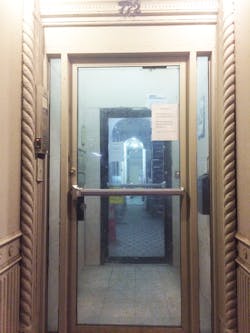In order to solve door problems, first you have to identify to problem. During the course of your work, how many disasters waiting to happen have you encountered?
Most locksmiths cannot walk through a door or pass through a facility without mentally assessing the condition of the doors, and the vulnerabilities of the security management procedures. The best part is being paid to do it.
Mark Berger, President & CPO, Securitech Group, is committed to developing products which meet today’s forced entry and access control needs, while maintaining life safety. He frequently consults with federal, state and local agencies to meet their emerging infrastructure security locking needs. Berger was kind enough to share a portion of his extensive collection of illegal door photos.
Securitech has over three decades of success in creating and delivering innovative products to meet the most demanding locking needs and life safety code requirements. The Securitech team is proud of their well-deserved reputation as the leading “go-to” American manufacturer for special locking solutions.
Securitech solutions are customer specific and always consider life safety and respect code requirements while providing the desired level of protection against forced entry. Working closely with fire and life-safety officials, Securitech solutions exceed UL and other standards having been field tested in the South Bronx to withstand the toughest levels of abuse.
Securitech was chosen to develop specialized electric locking for the Port Authority of NY/NJ’s electric locking project as part of the World Trade Center reconstruction after the 1993 bombing.
Major retailers across the U.S. rely upon Securitech for code‐compliant protection against forced entry.
Securitech’s Trident Series has enabled safe locking of exit doors and the innovative approach to alarming the door is recognized as the most effective method of notification. Securitech has developed innovative solutions for other major users including a life‐safety exit device and alarm for all of New York City Transit’s emergency gates, a user‐friendly gate locking system for Yankee Stadium and access control locking releases for existing locks on storefront doors.
Behavioral health is the latest frontier where Securitech’s innovation has led the industry to providing a safer environment. In this case, Securitech partnered with Stanley for national distribution and in a relatively short window, the anti‐ligature lockset became the product of choice for mental health professionals as they renovated or built new psychiatric wards in hospitals.
Berger has been accumulating images of door during his decades of consulting, and his extended circle of security professionals know this, and so they also send him images of bad doors they encounter themselves as security consultants.
Much of this sharing began before there was a phenomenon known as social networking or the many devices and ‘apps’ that have become essential for many folks these days.
This group of pictures are of doors on offices and restaurants, rather than historical sites, although some of these doors seem destined to become landmarks when poor innocent occupants fall prey to the carelessness and ignorance of accepted practices and building codes left behind by the individuals who worked on these doors displayed.
When you are looking at these pictures, you already know that there must be something wrong with each picture. Also, I’ll note, that looking at a picture sometimes does not convey the total experience, the impact of viewing a real life botch job.
So in the interests of continuing education for those of you who are perhaps new to the industry, or live sheltered lives, or just enjoy looking at doors, any doors; here is a sampling of the “Worst of” Gallery of Illegal doors.
Photo 1. “Really? Exit Device On Exterior”
The exit device is on the outside of door. How can people egress? Looks like it is an inswinging door, and the guy figured as long as the door had an exit device, the AHJ wouldn’t care on which side of the door it was on. So this is not an exit device, but more an entry device.
Photo 2. “Newest Latch Protector”
Note the makeshift guard plate. Anyone with a Philips screws driver negates the security. So besides looking bad, this modification is useless. I’m going to go out on a limb here and say I do not think a locksmith did this installation. OK I’ll rephrase: I think it is not likely a locksmith did this installation. Somebody should have told them about www.don-jo.com ,who has a large assortment of protectors for electric strikes and latches.
Photo 3. “Dangerous Movie Theatre”
This image was submitted by an associate of Mark Berger, John Ream. Definite fire hazard. 100+ people died in a Chicago fire when exit doors were chained like these doors.
Photo 4. “Pull hard”
If it requires pull to ingress, it also requires push to egress. Door fitting adjustment needed here. As we all know, hardware is not self healing, and whatever defect is causing the door to bind will only get worse. Causes could be damaged hinges, popped threshold, racked door frame, damaged door or some other accessory mounted on the door which is binding.
Photo 5. “Extra Hinges”
It’s impossible to align that many pivot points. This is a job for a continuous hinge for looks and performance. There appears to be a roll-up gate for this store. It appears the door frame is fractured at the top and bottom where the pivots would be normally located and possibly no viable sheet metal upon which to use pivots. There are pivots designed with extended flanges for use on wrecks like this. The time and effort that went into the installation of the hinges means to me that the owner didn’t have too much a clue, and he perhaps got his cousin to slam them on there.
Photo 6. “Door Sticks”
Same answer as Photo 4. This is a substantial wide frame door and you want to figure out what’s wrong and fix the damn thing instead of putting in time and expense to make that stupid sign.
Photo 7. “Blocked By Deadbolt Over Exit Device”
Solid bars may be accidently pushed in an emergency. These should be removed. Fast food chains typically take better care of their doors because they have deep pockets and customers are likely to sue. The solid cross bars are perhaps holding the door together as well as creating a hazardous exit situation. Flag down the garbage truck and throw the door in.
Photos 8 and 9. “Almost Got It Right”
Double bars can cause exit confusion. The close up of the bar near the head of the exit device really defies description.
It’s hard to believe the exit device actually retracts a latch. But if it did the exit device is mounted too high to meet code, and the fixed pushbar is a no-no. To properly mount the exit device would have meant getting involved with the mortise cylinder and the swing bolt the cylinder probably controls.
Sometimes mechanics do not know how to deal with fixed pulls and pushbars so they fake it. The mechanic might have been better off stopping someone passing by on the sidewalk and asking them how to proceed. It’s difficult to imagine the advice would have resulted in a worse outcome. Difficult but not impossible.
Photo 10. “ Grilled Exit”
This looks like a mall, and I hope they rolled down the gate so they could take the picture. Didn’t they see the tiny signs? The fire extinguisher does not belong there, and the thumbturn invites mischief. What’s with the guard rails and baseboard heating?
One thing for certain is this is a fire exit, but I do not see any positive latching. Perhaps since it is an interior door on an enclosed mall, the requirements are different. Why are we here anyway, rekey the roll up gate?
Don’t touch anything until you get the code requirements clear. Facility management should be able to tell you.
Photo 11. “Fire Hazard”
Exit door can be locked by key. Also, door closer arm is mis-adjusted. At least they are across the street from a fire house.
Photo 12. “Improper Traffic Cone Placement”
Perhaps secure, but not appealing. Deadbolt with thumbturn below does the same job. This setup creates a number of potential life safety and security issues, and will be flagged by the AHJ. Refer to NFPA 80. Besides the cone, which can be easily removed, but also put back once the inspector is gone, the slide bolt is prohibited.
The thumbturn, which appears to operate a swingbolt, must be replaced with a mortise cylinder to prevent unscheduled lockdowns and possible occupant entrapment.
Photo 13. “Hardware Finishes Clash”
If this is a fire door, the deadbolt should be disconnected.
This is a small sampling and we only scratched the surface. Thought or comments please share with our editor.






